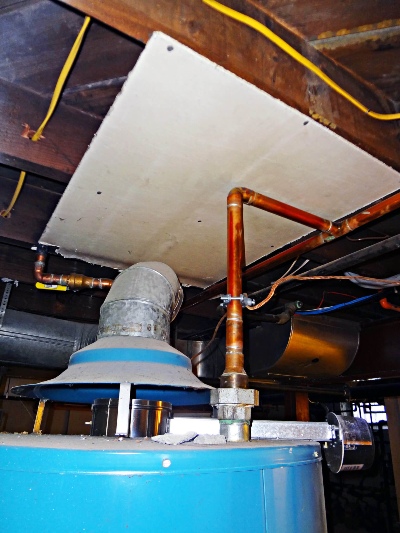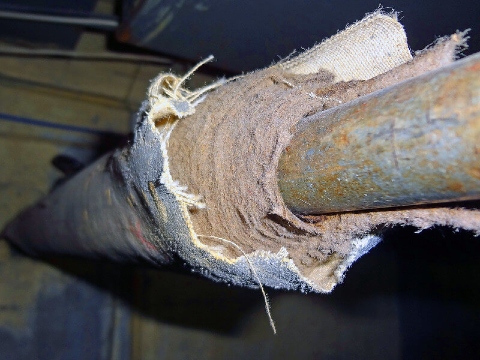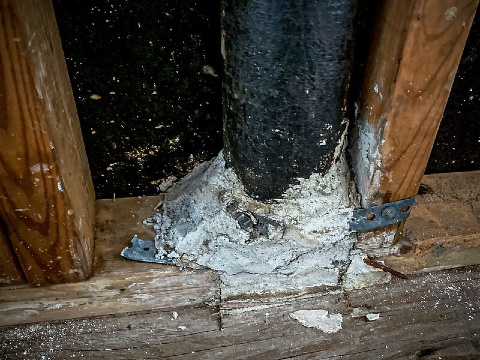Plumbers and Asbestos
Plumbers are at risk of exposure to asbestos products, including asbestos cement pipes, pipe wrap insulation and joint compound. Higher rates of mesothelioma and asbestosis are reported in plumbers because of their increased risk of asbestos exposure.

How Are Plumbers Exposed to Asbestos?
Plumbers may come in contact with legacy asbestos in older buildings and homes today, putting them at risk of developing serious conditions like mesothelioma or asbestos-related lung cancer. At the height of asbestos use in the mid-20th century, plumbers often worked directly with asbestos-containing materials.
Materials in residential and commercial plumbing systems that often contained asbestos included pipe insulation, cement, gaskets, valves and joint compounds that can withstand high temperatures and corrosion. Cutting asbestos-insulated pipes, removing sealants or grinding valves released microscopic fibers into the air. Plumbers working in tight spaces, such as crawlspaces or basements, often face prolonged exposure without proper protective gear. The increased when older materials became brittle and easily disturbed during repairs.
Many plumbers were unaware of the risk of asbestos exposure. Short-term exposure decades ago can lead to a diagnosis today. Mesothelioma has a long latency period of 20 to 60 years from initial exposure. Secondhand exposure also impacted family members who touched work clothes or tools with asbestos dust.
Asbestos Products Associated With Plumbers
Plumbers regularly handled asbestos materials like cement pipes and gaskets as part of their daily work. These products were chosen for their strength, fire resistance and durability, but later proved deadly.
These materials posed serious health risks during installation, removal and repairs. Disturbing them during cutting, scraping or sanding released asbestos fibers into the air. Plumbers who worked without respiratory protection or ventilation were at the highest risk.
- Cement
-
Asbestos cement was used to make many products, including plumbing pipes, toilets and pipe repairing compounds. Plumbers are at risk of asbestos exposure when they cut, repair or replace old cement pipes, remove old cement compounds or service older toilets made of asbestos cement.
- Heat Shields
-
Asbestos-containing heat shields were installed around hot water heaters, which may have been a source of asbestos exposure when plumbers had to remove or repair them. Sometimes these heat shields were made of asbestos millboard.

- Insulation
-
Asbestos insulation was used on pipes, boilers, ducts and tanks. Asbestos wrap insulation was applied around asbestos cement pipes, which presents two layers of asbestos-containing materials that plumbers have to cut through when making repairs.

- Joint Compounds
-
Asbestos was a common additive in joint compounds used by plumbers because it provided strength and heat resistance.

- Pumps, Valves and Gaskets
-
Old pumps, valves and gaskets were made with asbestos fibers, which plumbers may be exposed to when repairing or replacing these materials.
- Welding Rods
-
It is rare for traditional plumbers to use welding rods, but some commercial or industrial plumbers may have in the past, and they historically contained asbestos to regulate heat.
Manufacturers of Asbestos Products Used in Plumbing
Several companies made asbestos-containing products that plumbers used. These manufacturers are now linked to thousands of mesothelioma claims. Many have set up asbestos trust funds to compensate exposed workers.
Asbestos Product Manufacturers
Many of these asbestos companies continued to sell contaminated products for decades after the danger of asbestos became known. Their products were found on job sites across the country, contributing to diagnoses of mesothelioma among plumbers and other tradespeople.

Receive our updated 2025 legal guide overnight. Learn how to choose an attorney and access compensation.
Get Your Free GuidePlumbers and Mesothelioma
Mesothelioma is a serious cancer that disproportionately affects plumbers and other tradespeople with long-term asbestos exposure. Because asbestos was so common in plumbing materials, plumbers remain among the most at-risk occupations.
A 2024 study published in Respirology confirmed an elevated incidence of mesothelioma among construction workers, including plumbers. Most plumbers weren’t warned of the risks and didn’t wear protective gear while working with asbestos-containing materials.
An earlier study in the International Journal of Epidemiology found former plumbers were nearly 16 times more likely to develop mesothelioma than the general population. Another previous study in the European Respiratory Journal also reported that British plumbers face high rates of asbestosis from occupational asbestos exposure.
Inhaling asbestos fibers during brief repair tasks, like pipe repair, can cause mesothelioma years later. Symptoms appear gradually, often delaying diagnoses for many plumbers until after they retire. While treatments have improved, early detection is crucial. Those with exposure should have regular check-ups for asbestos-related illnesses.
Compensation for Asbestos Exposed Plumbers
Plumbers who develop mesothelioma as a result of asbestos exposure may qualify for compensation. These funds can help with medical costs, lost wages and support for family members.
Compensation eligibility depends on work history and product exposure. Filing a claim doesn’t impact medical care and can offer meaningful support to patients and families. Patient Advocates can help you file your VA claims. They can also connect you with experienced asbestos attorneys to help you document your exposure and guide you through the legal process.
Available Legal and Financial Options
- Asbestos trust fund claims: Bankrupt companies created these to set aside funds to compensate exposed workers.
- Personal injury lawsuits: Those diagnosed with mesothelioma or asbestos-related lung cancer can file against the manufacturers of asbestos plumbing materials.
- VA benefits: For veterans who worked as plumbers during military service.
- Workers’ compensation: For on-the-job exposure recognized under state laws.
- Wrongful death lawsuits: Those who have lost a loved one as a result of asbestos exposure may file against asbestos plumbing product manufacturers.
A $60 million verdict was initially awarded in New York in 2018 to the family of Pietro Macaluso, who died of mesothelioma. Macaluso was exposed while working as a plumber’s helper and laborer in the construction industry. The defendants appealed twice, and the award was eventually reduced to $6 million in 2019.
In California, a jury awarded $8.45 million to Robert Swanson’s estate. He died of mesothelioma from asbestos while working as a plumber and pipe fitter. In West Virginia, a jury granted Larry Stewart $7.2 million. He was a former Union Carbide employee exposed to asbestos during his plumbing career and was diagnosed with mesothelioma in 2007.
Recommended Reading


